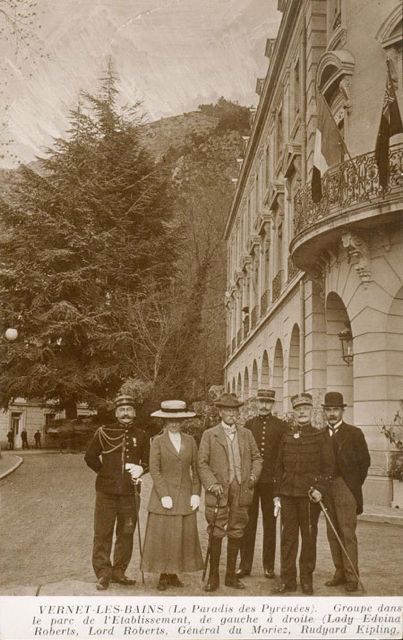 “I came here in search of nothing more than a little sunshine. But I found Canigou, whom I discovered to be a magician among mountains, and I submitted myself to his power… I watch him with wonder and delight. Nothing that he could do or give birth to would now surprise me, whether I met Don Quixote himself riding in from the Spanish side, or all the chivalry of ancient France watering their horses at his streams, or saw (which each twilight seems quite possible) gnomes and kobbolds swarming out of the mines and tunnels of his flanks.“Rudyard Kipling
“I came here in search of nothing more than a little sunshine. But I found Canigou, whom I discovered to be a magician among mountains, and I submitted myself to his power… I watch him with wonder and delight. Nothing that he could do or give birth to would now surprise me, whether I met Don Quixote himself riding in from the Spanish side, or all the chivalry of ancient France watering their horses at his streams, or saw (which each twilight seems quite possible) gnomes and kobbolds swarming out of the mines and tunnels of his flanks.“Rudyard Kipling
Highly fashionable ‘station thermale’ at the start of the XX century, today a pretty Catalan village with steep, narrow, flower decked streets, leading to the XII century church of of Saint Saturnin attached to the castle, a visit to Vernet-les-Bains is a delight in any season.
Recommended for respiratory and rheumatic disorders due to its sodium sulphur waters flowing down from the very heart of Canigou, it also makes a great base for exploring, whether driving or walking. The Cady valley and surrounding countryside is spectacular, and Canigou omnipresent.

The devastating floods of 1940 destroyed much of the flora and fauna in the area, when the River Cady poured out of the gorge at Casteil, rose to six metres, and burst its banks.
Locals reported seeing the river carrying ‘apple trees, cows on their backs, sideboards, wardrobes full of clothes and even a hotel, which floated for a few seconds before sinking into the water’.
On October 21st 1940, the headline of the Indépendant was ‘Vernet-les-Bains, yesterday Paradise of the Pyrenees, today Dante’s Inferno’.

After much restoration work, Vernet became the first “Village *Arboretum” in France with over 2,000 identified and listed trees in the village, and a promise that for each new child born in Vernet, a tree would be planted by the parents.
 For the geologists, a visit to the geological museum (only open in the summer) with its collection of rocks, minerals, fossils and crystals must not be missed out.
For the geologists, a visit to the geological museum (only open in the summer) with its collection of rocks, minerals, fossils and crystals must not be missed out.
The Fossils (mainly marine, 98% of which have been collected in France), represent all the geological stages covering a period from 550 million years (beginning of the primary era) til 2 million years (dawn of humanity).
Famous British visitors to the resort in the early 20th century included Rudyard Kipling, the Princess of Battenberg (daughter of Queen Victoria, nothing to do with the cakes), Lord Roberts and his wife, Scott O’Connor…..
Facilities for visitors were improved, magnificent hotels were constructed around the park, and sparkling evening parties held in the casino, built in 1880 by architect Viggo Dorph Petersen.
Today, Vernet remains a lively tourist resort, with bars and restaurants, casino, and of course its hot spring baths.
Take a 3km walk from the centre to the ‘Cascade des Anglais’ waterfall, following signs just off the D27 to Fillols, leading to a parking on the right. This wooded walk will bring you first to the waterfall of St Vincent and then, framed by rocky cliffs, La Cascade des Anglais.
Starting at the tourist office, stroll around the ‘Kipling circuit’, a short walk around Vernet with illustrated panels and quotations from Kipling’s own writings – the village seen through the pen of the celebrated author.

Look out too for the ‘Entente Cordiale’ monument next to the mairie, the only one of its kind in France, sculpted in Canigou granite by Roussillon sculptor Gustave Violet and representing France and Britain. Proposed in 1912 in honour of the wealthy Brits who frequented the fashionable spa town, the monument was completed at the end of WW1, and dedicated not only to the Entente Cordiale, but to the memory of those killed during the war.
In 1914, the “thermal plankton” deposit found on rocks where the spring water emerges was used to make a beauty cream marketed under the name of “La Vernétine” and presented as a “miracle cure for skin disorders”!
One hundred years later, in November 2014, Vernet launched Vitherma, a range of creams and cosmetics, with the subtle perfume of Roussillon fruit, based around the magical waters of the spa.
Over the centuries, the hot spring waters of Vernet have been drunk, bathed in…and even used for heating.

Today, one of the hot springs flows out of the ground at 66° from its source at the Hotel Portugal, (gracious and peaceful retreat for servicemen past and present) and heats part of the casino, and a local crèche, before flowing on to an ancient and fascinating ‘lavoir’ opposite the Hôtel Princess.
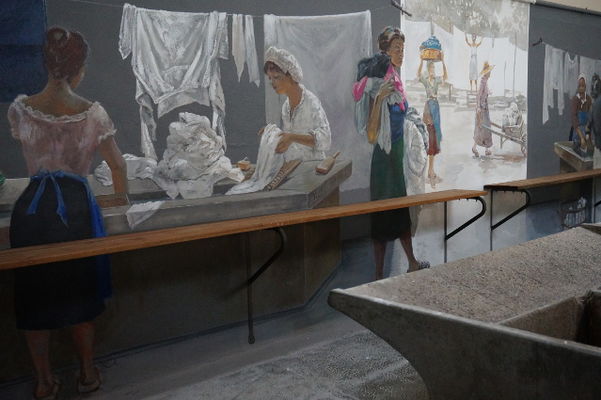
With delightful paintings by Dégas on the walls (copies of course!) and a striking ‘trompe l’oeil‘ around the sinks, this wash house is one of only a small number in Europe where you really can wash your dirty linen in public.
Locals and visitors still use the natural hot water for washing their smalls – and for a bit of fun, swipe your iPhone (or grab someone else’s if you’re not an iPhone owner!) on the codes on the walls and listen to the sounds of the washroom as it comes to life.
For more info on this dynamic little resort, check out the Tourist Office website, soon to be available in English at www.vernet-les-bains.fr
*arboretum – an area set aside for the cultivation of trees and shrubs for educational and scientific purposes. An arboretum differs from a botanical garden in emphasising woody plants, whereas a botanical garden includes investigation of the growth and development of herbaceous plants as well as trees and shrubs
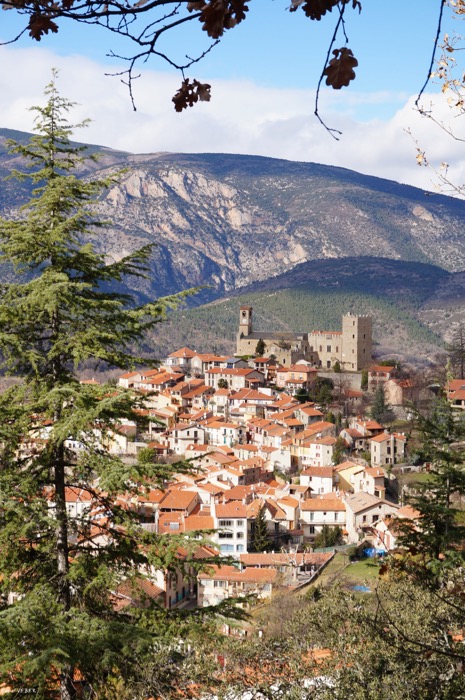
A short ride from Vernet, amidst dramatic scenery, is the Benedictine Abbey of St Martin de Canigou, a beautiful eleventh century abbey. You are aware that it has been a place of worship and meditation for centuries. Religious life continues to this day and you are asked to respect the silence and enjoy the beauty in peace.
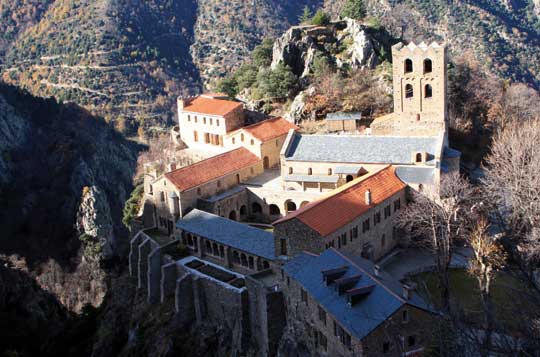
In 1428 it was badly damaged by a terrible earthquake and it wasn’t until 1902 that the Bishop of Perpignan bought the ruins and started the restoration of the abbey that continues to this day.
Of special note are two tombs hewn out of the rock by Count Guifred de Cerdagne, founder of the Abbey. His earthly remains lie in one, in the other those of one of his wives.
The little yellow train stops at Villefranche-de-Conflent, the nearest station to Vernet but a bus or taxi is recommended for the onward journey to Vernet.
The Canigou Race
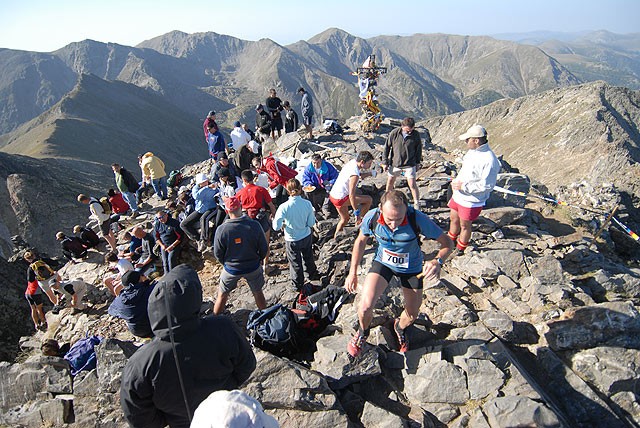
A haven of peace, quiet and pure mountain air, the area also provides challenging outdoor activities (walking, mountain biking, canyoning, rock climbing) due to its privileged position at the foot of Mount Canigou.
In August, the annual Canigou race honours the intrepid ice carriers, runners who used to climb high into the mountain, and cut blocks of ice from the hillside, running back down with up to 10 kilos in their backpacks to sell the fashionable hotels catering for the rich and famous taking a ‘cure’ in Vernet.
The fastest runners had the best chance of selling their ice. Today, whilst the race is open to both walkers and runners, many serious athletes run the course, carrying weights on their back.
It gives a whole new meaning to ‘on the rocks’!
